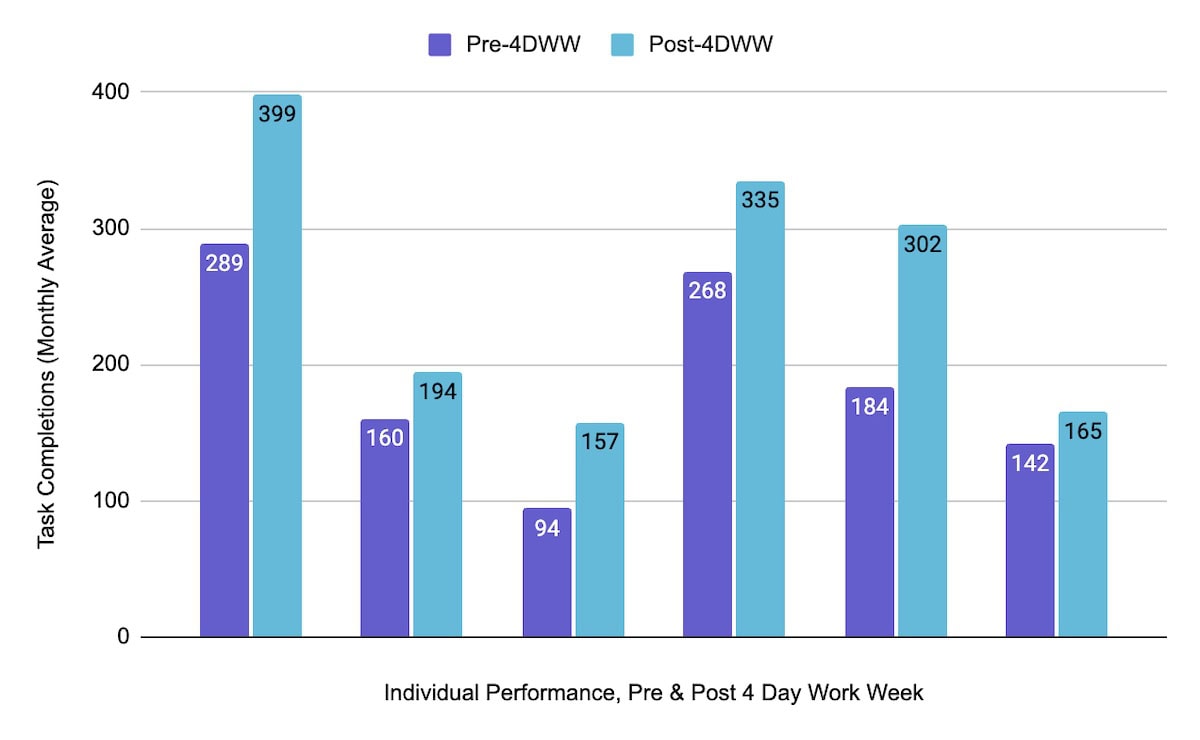
It’s well known that Americans value productivity and work. We are a culture that esteems advancement. We pride ourselves on developing the newest technologies and having the world’s highest GDP. Our cultural fascination with work helps fuel our economy, our social systems, and our innovation. It also gives us the freedom to pursue our version of the American Dream.
But for too long we have equated productivity with time worked. What if your team could get more done by working less?
Recent studies have shown that with reduced working hours, productivity remains the same, and in some cases increases. Armed with this knowledge, Xponent21 began working 32 hours a week, cutting out Fridays altogether at the beginning of 2020, and we’re delighted to share that we’ve seen similarly compelling results.
Contents
Our Values Are the Same – Even When Working A Four Day Workweek
After more than two years of working a four-day, 32-hour week, we can confidently say that our expectations for the quality and quantity of work we produce have not changed. We still value client satisfaction, taking pride in our work, and generating profit to compensate our employees fairly and give back to the community. We also evaluate each other on how we’re doing living up to the high standards we’ve set. Why? Because like many American organizations, we not only need to stay profitable to remain in business, but we also operate within a culture and a system that values productivity — and our people value it too. We simply understand that working more hours during the week does not equate to increased outputs. In fact, the numbers prove otherwise.
Within a few months of making the change to a four day week, we were singing the benefits of making Thursday our new Friday. Now, we are thrilled to share that Xponent21 experienced a 38 percent increase in productivity in terms of tasks completed per employee on average from 2019 to 2020 after implementing the four day workweek. Figure 1 shows the number of tasks completed per employee in 2019, just before we adopted a 32-hour week, and compares that to the number of tasks completed in 2020, the year we rolled out the change. The data entries with smaller changes generally correspond to members of our management team whose work was, and remains, less tactical. However, the data show that mid-level team members saw increases in productivity grow by as much as 67%.
Figure 1) Task Completions 2019 vs. 2020

The Cascading Benefits of Making Thursday Our New Friday
While it’s impossible to completely tease out the cause of all the improvements we’ve experienced over the past two years since we made the switch, we can definitively say that over this period, in addition to increasing workplace productivity, we grew our team, our service offerings, and our number of client accounts. We also extended more services to existing clients. As a result, over the past 30 months, our revenue has increased by 64%.
And while many of these changes have occurred in tandem, we recognize that there is a relationship between our growth, profitability, and working 32 hours a week.
For existing team members, working a four day workweek has given them more time to rest and recharge so they can confront work challenges more effectively and efficiently. In terms of adding new team members, we have been able to attract top talent by offering the unique benefit of working fewer hours and still receiving fair compensation. With more employees and more productivity across the board, we have not only grown our accounts and revenue, we have also benefited from improved team morale and increased excitement about what we’re doing at Xponent21. We’re building a culture that not only values productivity, but that creates space for all team members to contribute meaningfully across the organization.
Increasing Productivity While Reducing Time Worked Is Possible with the Right Tools and Technology
The numbers we pulled on task completion were taken from the work management tool we use, Asana. Using a work management tool like Asana streamlines our work across internal teams, organizes projects, serves as a repository for information, and helps us track our work so we can better manage our resources. Using Asana lets us keep our inboxes, and our brains, clear to do the important strategic work our clients enjoy. And it’s not just Asana, we employ a number of digital tools to help us increase our efficiency. Some tools help us maintain effective search engine optimization, others allow us to plan or automate workflows, while still others enable us to manage our clients’ online reputations.
In today’s digital age, an abundance of tools are available to professionals. Some tools require a subscription, but a lot are free (freeware). We have found that by utilizing these tools, many would-be time-consuming tasks become simplified, allowing us to spend more time developing client relationships and conceiving marketing models and workflows that deliver increased value add.
When You Invest in the Right Things, The Whole Team Benefits
If there’s one thing that Xponent21 is not, it’s risk-averse. We are willing to test the limits, try new tools, and invest in resources that are likely to reap positive benefits for us and our clients. Investing in new tools, processes, and our team has helped us improve our productivity. And with that improvement, we have seen growth – growth in revenue, in the size of our team, and in our collective and individual capabilities.
We strongly believe that investing in quality digital tools as well as in our team has far-reaching benefits. By investing in digital tools, we have given our team members the opportunity to not only develop further skills in digital transformation, but to free up time so they can pursue more creative and strategic work. In addition, prioritizing employee wellbeing by allowing flexible work schedules and cultivating a culture that listens to each other’s needs and ideas has motivated our team members to produce innovative, quality work while maintaining a good work-life balance. Making room for new tools, ideas, and employee wellbeing has not only improved our productivity, it has also benefited our clients and our community as our work gets completed more efficiently, leaving space for new client initiatives and community partnerships.
Moving to working 32 hours a week is a big shift from the traditional 40 we’re accustomed to in this country. But if it’s really productivity we value and the right tools and resources exist to make working 32 hours just as (or even more) productive than 40, what are we waiting for, America?
